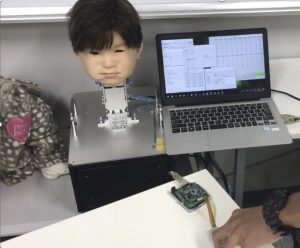In recent years, as advances in AI and robotics have brought humans and robots into increasingly close interaction, the question of whether robots need to “feel” pain has attracted growing attention. Traditionally, robots have been designed merely as tools; however, in fields such as caregiving and medicine, where emotional and ethical judgments are required, behavior beyond simple functionality has become necessary. Pain perception is not merely the detection of stimuli; it serves as a foundation for understanding the pain of others, fostering empathy, and forming moral judgments. Thus, research on artificial pain is a critical issue for robots aiming to coexist harmoniously within human society.
In his 2019 papers [1,2,4], Asada proposed the hypothesis that the pain nervous system is indispensable for the development of consciousness in robots. He pointed out the limitations of deep learning, particularly its lack of embodiment and social interaction, and argued from the perspective of cognitive developmental robotics that introducing artificial pain—combined with the robot’s own pain experiences and understanding of others’ pain through mirror neuron systems—could foster the development of empathy, morality, and ethics within robots. Prototypes of soft tactile sensors and emotion-sharing models provide concrete foundations for this hypothesis.
In his 2020 paper [3], Asada deepened this discussion by comparing the differences and commonalities between human and artificial autonomy. While current AI lacks a concept of self and realizes autonomy through mechanisms different from those in humans, he positioned this difference as relative rather than absolute and organized a hierarchical structure of autonomy. Furthermore, he examined in concrete terms the possibility that robots equipped with artificial pain perception and empathic capabilities could become moral agents, along with the accompanying legal and ethical responsibilities.
In his 2024 paper [5], Asada reconstructed the progression of pain perception as a process evolving from individual experience to social sharing. He incorporated the roles of memory and the influence of cultural and social contexts, proposing the possibility of generating empathy through multimodal integration in pain prediction models and collaborations with large language models (LLMs). He also discussed the impact of robot pain on societal ethics and legal systems, emphasizing the necessity of agile governance to keep pace with rapid technological advances.
Finally, in his 2025 paper [6], Asada proposed the new concept of “Silicopathy.” This is a developmental and embodied framework aimed at constructing moral agency in robots, starting from pain-based empathic learning. It leverages Deep Modality Blending Networks (DMBN) for multimodal integration and Oscillator-Driven Reservoir Computing (ODRC) for temporal prediction. Beyond short-term pain learning, it envisions integration with LLMs to represent “mental pain” grounded in long-term memory and social contexts. Moving beyond pain as merely a biological sensation, Asada argues that artificial pain, with its functional and social roles, has the potential to enable robots to exhibit behavior intelligible from an ethical perspective, presenting new challenges and prospects at the intersection of ethics, law, and technology.
[1] Minoru Asada. “Artificial Pain May Induce Empathy, Morality, and Ethics in the Conscious Mind of Robots.” Philosophies, Vol. 4, No. 3, p. 38, 2019.
[2] Minoru Asada. “Artificial Pain Leading to the Developmental Process of Consciousness: Empathy, Morality, and Ethics.” Tetsugaku (Philosophy), No. 70, pp. 14–34, 2019. (In Japanese)
[3] Minoru Asada. “Rethinking Autonomy of Humans and Robots.” Journal of Artificial Intelligence and Consciousness, Vol. 7, No. 2, pp. 1–13, 2020.
[4] Minoru Asada. “Empathy in Robots Induced by Artificial Pain.” Kagaku (Science), Vol. 93, No. 1, pp. 54–60, 2023. (In Japanese)
[5] Minoru Asada. “Robot Pain: Its Design, Development, and Ethical Issues.” In Proceedings of the 9th International Conference on Robot Ethics and Standards (ICRES 2024), pp. 192–195, 2024.
[6] Minoru Asada. “Silicopathy: Artificial Empathy through Cognitive and Affective Development of Pain.” Proceedings of the 25th IEEE International Conference on Development and Learning (ICDL 2025), 2025.
